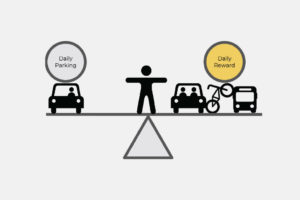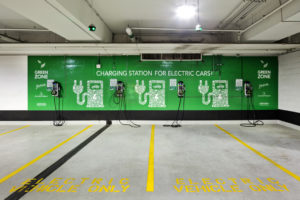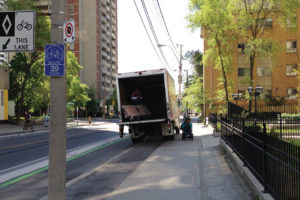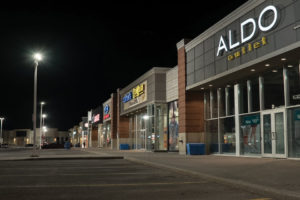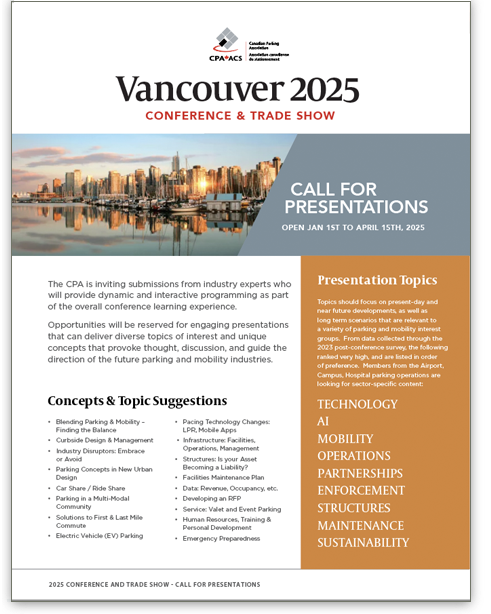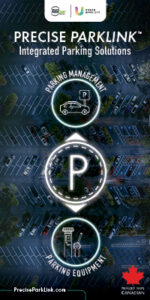By Yona Shtern
When I write the words “parking garage,” what comes to mind?
If you had asked me ten years ago, I would have likely said the following: A large structure. Often gray and cold in the winter. Perhaps not the most inviting place, but a place I need to go to store my car for some period of time – out of necessity.
Today? It would be a completely different response. Let me explain.
Ten years ago, parking garages were essentially passive real estate. They were large structures (often built and left alone) simply waiting for use. Sometimes packed with vehicles during the day or peak evening hours, causing drivers to circle block after block in traffic looking for a garage with an open space or an acceptable price. Other times, they could be eerily empty, especially during the overnight hours.
Today, things have changed. Now, I like to think of parking garages as hubs for connected mobility services.
Virtually every vehicle coming off the assembly line now has a modem with internet connectivity. 5G promises to deliver lightning-fast bandwidth that will transform the nature of connected content and mobility services. Large brands like Google, Amazon and Apple are focused on bringing convenient, connected features and their content to drivers and passengers in connected cars across the world.
While autonomous vehicles are still years away, connected mobility is quickly becoming a reality today. The promise of a driver pulling out of the garage having their coffee ordered automatically, their parking spot reserved and paid for, the nearest gas pump or EV charger primed and ready to fuel, and their route optimized to get to their first meeting or first pitch on time is already a possibility.
Additionally, voice-powered assistants like Alexa, Siri and Google Home…
By Sidharth Malhotra
Part 1 – A Simple Guide to Understand Blockchain with a Real-World Analogy
Everyone is talking about Bitcoin these days, from your barber to your friends working the stock market. Don’t worry. This article is not about making money from Bitcoin. However, I will try to help you understand the underlying technology which makes Bitcoin work and how this concept of blockchain can be useful in the coming decades.
Historical Overview
October 31, 2008, a white paper from an anonymous person or organization named Satoshi Nakamoto was published which explained a novel approach to send money from sender to receiver directly without involving any financial intermediaries. The paper gave a name to this concept — Bitcoin. Since, Bitcoin uses some underlying concepts of cryptography, this new way of exchanging money was categorized as cryptocurrency. The only purpose of Bitcoin was for financial transactions, but researchers realized that its foundational technology can be harvested to build other secure and robust applications that can revolutionize the way current systems work. “Blockchain” was the name given to this foundational technology. Lots of technical words? Let’s simplify!
What is Blockchain? — A Real World Parking Analogy
Centralized Parking Scenario
Let’s imagine that you live in a city, which has space to accommodate 200 cars at one time (assume that there is one parking structure with a ground floor). This facility has a main gate which stays locked and is only opened when a car moves in or out. Now let’s analyze this single parking building from different points of view.
Price: Since some private company built this parking facility exclusively for parking purposes and all the maintenance and operating costs will be borne by the owner company, there will be a high fee for renting out a single parking space.
Security: If…
By Blake Laufer, Founder, MiStall Insight Inc.
I often hear about parking operations lamenting that they are unique. And they are. Very few industries are simultaneously impacted by their physical layout, special interest groups, pricing limitations, weather conditions, political agendas, and technological advancement – all at the same time.
Subsequently, with so many moving parts it’s difficult for parking operations to measure their success. How is my operation doing? Are we profitable? Are we serving our parkers fairly? Am I succeeding as a manager?
We are not alone. Many other industries have similar challenges to parking, and so instead of examining what makes parking different, we should look at how parking is the same. Furthermore, we can learn from other industries how they measure success, and we can adapt those measures to ourselves.
Supply and Demand: It’s the Law
As you’re probably aware, the Law of Supply and Demand works to balance the amount of supply (product available from manufacturers) with demand (amount of product desired by consumers). When prices are higher consumers buy less and manufacturers produce less; when prices are lower consumers buy more and manufacturers produce more.
The Laws of Supply and Demand can be distorted by various factors. One such distortion occurs in the fixed-supply industry where there supply of product is scarce, like parking. In parking the “manufacturer” is the parking operation, and the parking operation cannot easily change the supply of parking spaces in the short-term. (Over the long-term it’s possible to change your supply – build a new garage, for example, but over the short-term we have roughly the same number of parking spaces available to be sold every day.)
Other fixed-supply industries include airlines (with a fixed number…
BY PAULO NUNES-UENO
Parking is out. Mobility is in.
Strolling the vendor booths at the Canadian Parking Association conference in Toronto this year makes that clear. We are all rebranding, it seems. Including me. The group I started at Seattle’s DOT, called the Transit and Mobility Division, manages transit, bikeshare, carshare, and of course, parking. Now as a consultant, I help clients retool their campus and city parking into ‘mobility’ services.
Mobility. Such a sweet word. If you close your eyes, you can almost hear…the future! Unfortunately, the transportation and ecological challenges we face won’t be solved through slogans. And the stakes couldn’t be higher. Get ‘mobility’ right and we stand a chance against climate change. Getting it wrong also spells extinction for those in the parking–I mean mobility–business.
Technology changes and growth make real adaptations all the more urgent. Re-urbanization is transforming cities throughout North America. Companies that a generation ago would have happily sprawled in suburban office parks are packing into downtown skyscrapers. Witness the new Amazon HQs headed to NYC and Washington DC. We can actually see this change happening inside our workplaces. The typical office from the early 2000’s housed 3 or 4 people per 1000 square feet. Today interior designers and architects with open offices and shared workstation have managed to more than double that.
Too bad transportation can’t claim anything close. None of the innovations to date increase the capacity of roadways or parking lots very much.
Driverless cars, the next big ‘innovation’ afoot, will actually make matters worse. Though we don’t know when autonomous vehicles are coming exactly, we can be sure they will impact the urban landscape. How? Because we have experience with services that drop people off at their destination and keep going. They’re called taxis….
By Jennifer Mucha
Toronto Pearson is Canada’s largest airport, and the ninth-busiest airport in North America, moving nearly 50 million annual passengers from security checkpoint to gate to more than 170 destinations around the world. The airport has a mandate to put passengers at the heart of every decision, and as a result was recently recognized by the Airports Council International as the Airport Service Quality best large airport in North America. Believing that the passenger experience starts long before take-off, Toronto Pearson is using technology and analytics to build a diverse and creative transportation offering that ensures travellers have an end-to-end experience tailored to their individual needs, while keeping future aviation demand in its sights.
Toronto Pearson has come a long way from its origins in a farmer’s field in the village of Malton in 1939. The airport grounds now stretch from Mississauga in the west to the city of Toronto in the east and south, and to Brampton in the north. At the heart of three municipalities and close to the 400-series highways, it goes without saying that Toronto Pearson sees high vehicle traffic from passengers, meeters, greeters and employees.
Integrating Parking and Transportation
With nearly 50 million annual passengers, as well as an airport employee community of almost 50,000 workers, efficient transportation into and out of the airport is critical to the success of the operation. An intricate network of municipal transit providers, ground transportation operators and the airport’s own Parking and Ground Transportation business unit work together with a common goal: to ensure that transportation at the airport is integrated, provides a diverse and appropriate range of services and contributes to the airport’s passengers-first mandate.
Achieving that goal is no small feat. Toronto Pearson’s three covered garages and two outdoor lots represent Canada’s…
By Mark Hutchinson, Vice President of Green Building Programs, Canada Green Building Council
The changing nature of the parking and transportation industry has highlighted the importance of understanding the sector’s environmental impact and its key role in mitigating climate change. Among those leading the charge in this area is the Yorkdale Shopping Centre in Toronto’s North York area, which has been no stranger to innovative new initiatives throughout its 50-year history, including a number of sustainability efforts as part of its green program.
In July 2018, the mall achieved Parksmart certification at the Pioneer level for existing parking structures by obtaining more than 90 points for its G Parkade southwest parking garage, and in August, Yorkdale’s newly constructed E Parkade east structure certified Parksmart Bronze by achieving between 110 and 134 points. These are the first Parksmart certified projects in Canada – and the first retail certifications in the world.
The Parksmart rating system is administered in Canada by GBCI Canada, which is jointly-owned by the Canada Green Building Council (CaGBC) and Green Business Certification Inc. (GBCI). Designed to advance sustainable mobility through smarter parking structure design and operation, Parksmart helps parking structure owners and managers ensure their assets are future-proof and functioning optimally in order to maximize operational savings.
For both Yorkdale projects, the Parksmart certification process has served to highlight opportunities to maximize and modernize parking assets, ensure strong returns on investment, and provide an enhanced parking experience for mall patrons.
Redefining parking as part of a broader green strategy
Yorkdale has had green initiatives in place for more than two decades, from being one of the first shopping centres in Canada to implement a recycling program, to more recent measures such as the utilization of reusable tableware and cutlery, organics composting and an urban…
By Chelsea Webster
What affects 1 in 3 Americans, costs trillions of dollars annually, and is a complete mystery to most people?
Why You Should Care About Cybersecurity
There are close to 400 cyber-attacks every single minute in the US, which affect 1 in 3 Americans every single year. It costs companies an average of $15.4 million annually to manage hacks against them, with total annual damage estimated at $6 trillion by 2021.
The point of these stats is not to make you paranoid, but to highlight how real, common, and far reaching cybersecurity threats are. It’s also to get you to take one more step in your thought process and connect cybersecurity to your vehicle – your connected car – knowing that online threats are targeting people everywhere. It should get you thinking about how many cars there are, how big a target market that represents for hackers, and what you can do to protect yourself and your vehicle.
The Connected Car
So, what exactly IS a connected car? A connected car is any vehicle that has wireless connectivity to the Internet and/or other devices, like a satellite or an auto manufacturer or another vehicle or pedestrian. A connected car collects, sends and receives information, processes it, and actions it or alerts the driver to information that requires human action. The image below from the Future of Privacy Forum is a great visual explanation of some of the components.
What Data Does a Car Collect?
Your vehicle is a nosey piece of machinery. It collects external data on traffic, road conditions, signage, markings, weather, and lots more. It also collects a boat load of internal data on you through cameras and microphones. That data can be anything from eye movement to driving habits. The connected car…
By Peter Richards, IBI Group
Introduction
IBI Group worked with the City of Toronto on the Curbside Management Strategy. The City of Toronto has seen and continues to experience significant growth with substantial development adjacent to its right-of-way, resulting in considerable demands on the road network and excessive congestion; especially in the downtown core. Currently, curbside access (use of the shared space on a roadway adjacent to the sidewalk) is in high demand for motorists, cyclists, operators of transit, taxi, motor coach, courier and other deliveries/goods movement vehicles, and many other users.
The Curbside Management Strategy’s objective is to improve upon the efficiency and effectiveness of curbside space allocation and usage for all parking and loading activity, and to reduce congestion in the study area. The study area is bounded by Lake Shore Boulevard / Harbour Street, Bathurst Street, Queen Street, and Jarvis Street in Toronto. Between University Avenue and Yonge Street, the Study Area extends northerly to Dundas Street.
Activities under the Curbside Management Strategy (CMS) will help manage traffic congestion by:
- Using innovative solutions to improve the balance of safe access for people and goods with mobility;
- Reducing illegal parking which may affect traffic flow; and
- Increasing legal parking availability and reducing parking “search time” (i.e., cruising).
The CMS study involved the following overall tasks – reviewing of existing conditions, assessing future condition impacts, outreach and stakeholder engagement, reviewing best practices, developing strategies to evaluate, and recommending a set of policies and a proposed implementation plan.
Existing Conditions Review
The objective of the Existing Conditions review was to study the existing transportation conditions and curbside usage, issues, and opportunities in downtown Toronto within the proposed study area. This included a high-level review of existing City of Toronto policies and commitments, to ensure adherence and consistency for any potential recommendations. Some significant issues…
By Daniele Desjardins
In conjunction with the Canadian Parking Association’s Annual Conference and Trade Show, Parking, the Urban Mobility Perspective, Canada’s 1st Unified Mobility Leadership Summit will be held in Toronto from September 16 to 19, 2018.
The event comes as a result of the long-standing relationship between the Canadian Parking Association (CPA) and the Association for Commuter Transportation of Canada (ACT Canada), the only organization dedicated to sustainable mobility in Canada.
Moreover, the event epitomises the new mission statement adopted unanimously by the CPA Board of Directors at its strategy session held at the start of 2018: Connecting Parking and Mobility Professionals in Canada.
Both organizations’ annual meetings will be held simultaneously under one roof, where delegates are encouraged to take in the shared programming, to underscore the intertwined futures of parking and mobility, and help amplify the CPA’s conference theme.
In 2016, CPA and ACT Canada held concurrent events in Ottawa and shared some sessions and events that were of mutual interest. This year, the partnership between the two organizations has been purposefully strengthened and aligned so that programing is accessible to all delegates. The intent is to position parking as a key component of an overall unified mobility strategy and focus.
The CPA and ACT Canada relationship dates back to 2005, with CPA’s participation on ACT Canada’s National Advisory Team to help identify cross-sector issues that impacted integrated mobility across the country. Back then, a reciprocal agreement was established to formalize the relationship and set up goals to work together collaboratively and develop meaningful synergies, networks and information sharing.
“Since then, the commonalities between the two organizations have evolved not only inwardly, but as a collective undertaking across all transportation and mobility-related sectors. CPA hopes to lead the association market in adapting to new…
By Jason Broadhurst
Anchored by notable retailers Loblaws, Home Depot and LCBO, College Square is a retail complex with forty-nine brand name stores, spanning 389,244 sq. ft. The shopping destination has been serving a busy area near Algonquin College, in Ottawa, Ontario since 2003.
When property managers Leikin Management Inc. moved forward on an exterior lighting upgrade, they had four very clearly defined objectives.
“Saving energy was the primary concern,” explained Barbara Farber, for Leikin Management. “We also wanted to reduce maintenance costs, improve the aesthetic quality of the complex, and make the area even safer after dark.”
The property management firm teamed up with Concept Illumination, a company known for its exterior and parking lot expertise, to plan and execute the renovation, which was subsequently completed over two phases. First, wall packs along the rear of each block of buildings were replaced with the latest LED products.
With several of the then existing wall pack lights burned out and daylight hours shortening in the middle of the Ottawa winter, Concept Illumination understood the urgency of replacing the lighting as quickly as possible. Despite battling freezing rain and snow, the install of the wall packs was done within a day, minimizing disruption to tenants and ensuring that the complex remained a safe place to visit.
With the LED wall packs being more directional than the predecessors, it was possible to get light on the building in the exact distribution pattern required to illuminate columns and doorways. The LED wall packs used are 0°-90° adjustable, and are fixed in this case at 15° to enable sufficient aesthetic light on columns and walls, while throwing enough light forward and away from the building to be functional for illuminating the immediate surrounding areas.
Combined with the control of the light distribution, the 4000K colour temperature resulted…





